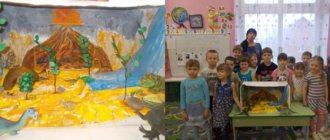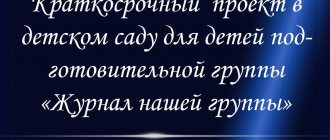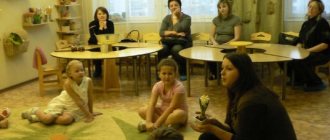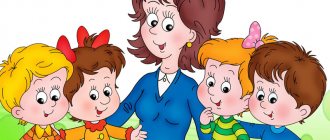Project activities as a means of introducing preschoolers to fiction.
Modern education is at a new stage of development - it is being modernized. In this regard, the educational institution is focused on a creative, successful person, so updating the content of preschool education, technology and quality systems is natural.
Introducing the younger generation to literature is one of the priorities of modern education. Reading works of literature is considered today as an essential element of culture. Meanwhile, a number of negative trends in the field of children's literature and children's reading have recently emerged. The active introduction of computer and information technologies into a child’s life reduces the status of literature, and the share of reading in the structure of children’s free time is sharply reduced.
Parents who read are role models. But at present the family is in a state of crisis, and due to a number of objective reasons its influence on the formation of a child reader is difficult. This process is facilitated by the lack of proper attention to the process of developing the child’s reading interest on the part of the father and mother. Children have little in common with books, and this is reflected primarily in their intelligence, literacy, moral and emotional development.
Through fiction, we introduce the child to the values without which the spiritual life of society and the individual is impossible. Currently, this is very important, since society is experiencing a moral and moral crisis.
The Federal State Educational Standard for Preschool Education includes the task of familiarizing preschoolers with book culture in the educational field of speech development, the main goal of which is to develop children’s interest and love for books, and to educate future readers [2, clause 2.6. Federal State Educational Standard DO].
Based on this, we can conclude that the state and society have put forward requirements for introducing students to fiction, but in practice it is impossible to fully introduce them, since:
- the child shows no interest in fiction;
- the child is careless with the book;
- there is no system in working to introduce preschoolers to fiction;
- indifference on the part of parents to the process of introducing preschoolers to fiction.
This problem requires an immediate search for a solution, since fiction is the basis on the path to knowledge. In our kindergarten, much attention is paid to project activities, which, of course, is one of the effective ways to solve this problem, because it is in project activities that such important principles as cooperation between the teacher and children and the principle of joint development are combined. Another important detail is that it is the method of project activity that gives children the opportunity to independently acquire and synthesize acquired knowledge, develop creative abilities, and communication skills. Another undoubted advantage of this method is that it allows parents of preschoolers to be involved in and reveal the values of joint creativity with their children, as well as increase their competence in introducing preschoolers to fiction.
From the work experience of teachers at MBDOU “Kindergarten No. 397” g.o. Samara: Passport of the project “In the World of Fairy Tales”
Project title : “In the world of fairy tales.”
Type of project: educational - creative.
Project developer : Efremova Natalya Aleksandrovna, Mukhankina Yulia Viktorovna, Pulargina Anzhelika Sergeevna, Surikova Olesya Vitalievna
Project participants: educators, preschoolers, parents.
Project duration: 3 months
Problem : Lack of interest in reading fiction.
The goal of the project : introducing preschoolers to fiction, educating the future reader.
Main goals:
- introduce children to a variety of different literary genres (fairy tales, stories, poems), folklore works (counting books, nursery rhymes, chants, lullabies, riddles, proverbs, etc.)
- cultivate the need to communicate with books, a culture of reading, and respect for books.
- develop children's speech, expand their horizons and vocabulary.
- involve children in speech, music, art, and play activities related to the image structure and plot of a fairy tale;
- develop memory, imagination, attention;
- form an emotional response to literary works.
Forms of work on the project:
With kids:
- reading and viewing fiction;
- conducting didactic, verbal, role-playing games with children;
- dramatization of fairy tales with children;
- conducting GCD;
- independent visual activities based on fairy tales (drawing, coloring, modeling, appliqué).
With parents:
- familiarization with consultations, recommendations, advice;
- Involvement in participation in creative work carried out jointly with children.
Expected results:
Metasubject:
- Cognitive:
- the preschooler is familiar with works of children's literature;
- children have an idea of what and how books are made, what great value they have for understanding the world;
- the cognitive interest of preschoolers is formed;
- the vocabulary of preschoolers is enriched;
- Children have a fairly good command of oral speech.
2. Communication:
- the child has developed a stable interest in books and fiction;
- preschoolers have developed the ability to coherently, consistently and expressively retell short fairy tales and stories;
- Every child is involved in creative activities.
3. Regulatory:
- the child understands that books must be taken care of.
4. Personal:
- a preschooler shows initiative and independence in various types of children's activities, play and communication;
- preschoolers have formed an emotional attitude towards literary works;
- Children are emotionally developed, able to empathize, and inquisitive.
Result, product of project activity: production of a tabletop puppet theater, drawings, crafts, appliqué work.
Development prospects:
- introducing preschoolers to various works of fiction and folklore;
- introducing preschoolers to fiction;
- enriching the “reading experience” of children through works of various genres of folklore (chants, fables, counting rhymes, fairy tales), literary prose (stories with moral overtones) and poetry (author’s riddles) - expanding children’s horizons;
- increasing parental competence in introducing children to fiction;
Stage 1: Preparatory:
- Conduct a survey of children “Through the pages of fairy tales”;
- Questioning parents “The role of fairy tales in raising children”;
- Defining the topic, purpose, content of the project;
- Select sources of information
- Set certain tasks.
- Determine the project timeline.
Search for materials on this project topic. Selection of fiction. Selection of illustrative material on the topic of the project. Learning poems about animals and fairy tale heroes. Selection of information material for the parents' corner. Development of notes on cognitive, speech and creative knowledge. Selection of board and printed games, finger games, didactic games, figurines of fairy tale heroes. (2 weeks. During regime moments.)
Stage 2: Practical activities:
- Conversations “What fairy tales do I know”; acquaintance with Russian folk tales (“Teremok”, “Ryaba Hen”, “Rukavichka”, “Fox with a rolling pin”, “Three Bears”)
- Examination of illustrations for fairy tales;
- Organization and conduct of modeling classes: “Modeling fairy tale heroes” - examination of illustrations for fairy tales;
- Organizing and conducting classes in modeling “Treats for the animals”, “Logs for the tower”, “Forest and garden apples”;
- Organization and conduct of drawing classes - non-traditional drawing - “Tree of Friendship” (blotography); decorative drawing" Decorate the mitten", "Beautiful rolling pin for the fox";
- Dramatization of Russian folk tales at the request of children;
- Construction: “Beds for three bears, “Teremok for animals”, “House for Ryaba’s chicken”
Musical activity: Learning songs from fairy tales
Game activity: “Correct the mistake.” Goal: to develop the ability to reconstruct events sequentially from present pictures. oven game “Fairytale Lotto”, “Tale after Tale”, “Fairytale Carousel”, “Geese-Swans”, “At the Bear in the Forest”.
—Memorization of folklore works (proverbs, chants, counting rhymes, tongue twisters, etc.).
- To develop the ability to evaluate the actions of fairy-tale characters
- Develop memory, imagination, attention.
- Cultivate a love of fiction.
- Cultivate a desire to listen and remember fairy tales.
- Cultivate a sense of empathy and kindness.
- Develop skills in handling books carefully.
Maintain interest in dramatizing favorite fairy tales. Learn to convey the structure of a fairy tale using modeling. To develop the moral qualities of preschoolers. To develop interest in theatrical and play activities. (3 months During regime moments.)
Stage 3. Working with parents:
- Consultation “The role of fairy tales in the education of preschool children”;
- Visual and informational cooperation “What and how to read to children at home”;
- Conducting a parent meeting using ICT technologies: “Family reading to children”;
- Drawing competition “My favorite fairy-tale hero.”
Joint creativity with children: making “baby books” based on their favorite fairy tales. (3 months).
Stage 4 Final.
Project results: Production of a tabletop puppet theater; Exhibition of drawings; Exhibition of “baby books”.
To summarize, I would like to note that project activity in the process of introducing preschoolers to fiction is a fairly successful method of activity for our teachers. Positive results were noted. The level of development of interest in fiction on the part of preschoolers has changed positively.
Children began to show interest in listening to literary works more often. With great pleasure, the preschoolers began to analyze the text, answering questions about the work they had read. Children began to take more active part in games - dramatizations of works of art based on text, to show creative initiative in reproducing the plot, creating images of heroes.
Children successfully master the program material, use the acquired knowledge, skills and abilities in direct educational activities, educational activities during routine moments, and in independent activities. The vocabulary of preschoolers has been enriched. Children develop a sufficient level of dialogic and monologue speech, which parents readily note. Preschoolers have become more emotionally responsive, friendlier, and more inquisitive. Children began to treat books more carefully. In conclusion, I would like to note that no one has ever been given a love for a book from birth, therefore, in order for a child to fall in love with it, a lot of serious work is needed.
Literature: 1. Ushakova O. S. Introducing preschoolers to fiction. - M.: Publishing house. Litera, 2012. 2. Kurbatova S. I. Experience of gender education of children through exposure to fiction / S. I. Kurbatova // Preschool pedagogy. - 2012. - No. 3. 3. Obnosova Kh. A. Introducing children to fiction in modern society // Culture and education. - May 2015. - No. 5. 4. Migunova E. V. Theatrical pedagogy in kindergarten. - M.: TC Sfera, 2009. Kiseleva L. S. Project method in the activities of a preschool institution: a manual for managers and practical workers of preschool educational institutions / 5th ed., revised. and additional - M.: ARKTI, 2010 - 95 p. 5. Solodyankina O. V. Design system in a preschool institution: a methodological manual. - M.: ARKTI, 2010 - 78 p. 6. Veraksa, N. E. Project activities of preschoolers: a manual for teachers of preschool institutions / N. E. Veraksa. - M.: Mozaika-Sintez, 2014. 7. Veraksa, N. E. Approximate general educational program for preschool education “From birth to school” / N. E. Veraksa. - M.: Mozaika-Sintez, 2022. 8. Law of the Russian Federation on Education. Order of the Ministry of Education and Science of the Russian Federation (Ministry of Education and Science of Russia) dated October 17, 2013 No. 1155 Moscow 9. “On approval of the federal educational standard for preschool education.” The concept of spiritual and moral development and education of the personality of a Russian citizen. 10. website of the Ministry of Education and Science of the Russian Federation. 11. website of the Ministry of Education and Science of the Samara Region.
Author: Mukhankina Yu.V.
Photos: Pexels
Tags:Books by Mukhankin Yu.V. Preschool experience Social and communicative development
Transcript
1 FORMS AND METHODS OF WORK FOR INTRODUCING PRESCHOOL CHILDREN TO FICTION MBDOU d/s 87 “Rassvet”, Bryansk Message prepared by: teacher Yatskova Larisa Vasilievna
2 1. Reading fiction Reading in free time (before bedtime, before meals, etc. .); Reading followed by discussion of program works, implying their further analysis.
3 2. Retelling and memorizing works of fiction Retelling a text involves children conveying the main content of a story or fairy tale, memorizing a poetic work by heart and expressively reproducing it accurately. Retelling is a form of work that integrates the tasks of familiarization with fiction and speech development. Memorization is the most important type of work that contributes to the development of speech, memory, thinking, and imagination.
4 3. Theatrical - play activity Theatrical play, based on the plot of a nursery rhyme, song, short poem or fairy tale, is carried out in different forms: - in the form of a round dance, from which children take turns going to the center of the circle and saying role-playing lines; - in the form of a mask theater, preschoolers put on masks (or hats) of the main characters and act out a plot or scene from the work; - in the form of a bibabo puppet theater, children, sitting behind a screen, role-play a story or fairy tale.
5 Dramatization games and literary productions require from the child not only knowledge of the text, but also the ability to transform, using various means of expression (gestures, facial expressions, intonation). In the dramatization game, preschoolers clearly express their personal attitude to the events depicted and to the hero. These games are based on fairy tales that are dynamic in nature. Literary production is a more complex type of theatrical activity. During its preparation, children get acquainted with the work, discuss it, sequentially focusing on each character.
6 Role-playing game, the leading activity throughout the preschool period, reveals children’s abilities to reflect significant situations of communication and social interaction.
7 4. Productive activity Children depict in drawings, crafts, appliques the characters of their favorite work or some of its episodes, conveying their emotional, personal attitude. Such creative activity helps to penetrate deeper into the literary image: children think through characteristic details, trying to convey the characteristics of the characters and the specifics of their relationships. Another form of work is individual, subgroup or collective creation of a book. This could be a book written and illustrated by the children themselves.
8 5. Cultural and leisure activities Cooperation of a preschool organization with a children's library; Excursions to museums, visits to theaters; Literary and art exhibitions and competitions; Thematic promotions.
9 Cooperation of a preschool organization with a children's library An invitation to the world of books is carried out in a preschool institution by a library worker together with teachers. A library employee explains what a library is and how it works. Children's excursion to the library. Preschoolers, teachers and parents visit the library, where they are given a short tour of different rooms. The meeting with the writer (poet, illustrator) is conducted by library staff. Literary competitions are organized by library staff. Preschoolers and their parents (optional) take part in them.
10 Excursions to museums, visits to theaters. Attending performances in children's theaters plays an important role in enriching the literary experience of preschool children and developing their creativity and imagination.
11 Literary and artistic exhibitions and competitions Approximate topics of literary competitions: literary production competition “On the pages of the books of S. Ya. Marshak”; dramatization competition “Our Chukovsky”; reading competition “We love and protect nature”, “Autumn poetry”, etc. Approximate topics of art exhibitions: books celebrating anniversaries; my favorite fairy tale; my favorite literary hero; an original book written and illustrated by the whole family.
12 Thematic events are charity events that are educational in nature for both preschoolers and their parents. Examples of thematic promotions: collection of waste paper; repair of books (in the group library and preschool library); tree planting; collection of books for pupils of an orphanage or orphanage.
13 6. Cooperation with parents of pupils The family is a unique educational institution that has powerful potential in introducing a child to fiction. If a book has moral and educational value in a family, a love of reading is formed in the child from early childhood. Making the student’s family an active assistant in this work is the most important direction of the teacher’s activity.
14 7. Forms of cooperation with parents Questioning. Identifying the family’s attitude to this problem. Visual pedagogical propaganda: screen “Issues of family reading”, “How to teach a child to love a book”, “Features of the development of a young reader”, “Reading for joy”, “Fairy tales in the computer age”, “Children and poetry”, etc.; information stands “What to read to a younger preschooler”, “What to read to an older preschooler”, “We teach poetry”, “How to discuss a book you’ve read with your child” (practical advice), etc.; booklets “Pick up a book and you won’t get bored”, “Reading with a child”, “Books and knowledge”, “Books and creativity”, “Reading and drawing”, “Educating with books”, etc.; exhibitions of children's creativity.
Project type: practice-oriented
Project duration: long-term. (1 year)
Project participants:
- children of preparatory groups for school,
Relevance of the project:
The process of communication between a preschool child and a book is a process of developing his personality. The most important role of books in the formation of a person was discussed back in the time of Yaroslav the Wise. A book should enter a child’s world as early as possible, enrich this world, make it interesting, full of extraordinary discoveries. A child should love a book and reach for it.
But, as you know, modern children increasingly spend their time playing computer games, watching TV shows and reading books less and less.
In conditions where entire electronic libraries are being created, it is difficult to force a child to pick up a book, especially a preschooler, because he is a kind of reader. The word “reader” in relation to preschool age is conditional. In reality, it is the listener whose encounter with the book is entirely determined by the adult, from the choice of text to read to the duration of the interaction with the book. Taste, interest in a work, its interpretation, the ability to navigate the circle of children's reading, the creation of a reading system - all this is in the power of an adult. It largely depends on the adult whether the child will become a real, enthusiastic reader, or whether a meeting with a book in preschool will be a random, meaningless episode in his life.
The attitude a child develops towards the process of reading and towards literature also depends on the attitudes of the adult.
Today, the relevance of solving this problem is obvious, because reading is associated not only with literacy and education. It forms ideals, broadens one’s horizons, and enriches a person’s inner world. Books have a special charm: books give us pleasure, they talk to us, give us good advice, they become living friends for us.
In a kindergarten, a survey of children and parents was conducted to determine the degree of influence of books on the formation of children’s moral ideas, which showed that 80% of children and parents prefer watching TV and playing on the computer. Modern children have TV and a computer as the background of their lives; they are perceived as members of the family; many eat, play and even fall asleep to its sounds. Only 20% of respondents preferred reading books. All these facts contributed to the development of this project.
We need to find effective forms of work to introduce children to reading, captivating preschoolers and their parents.
Target:
To promote the formation of a child’s sustainable interest in literature as an art form. Attract children to books, strengthen their interest in reading, including family reading.
Tasks:
- Introduce children to book culture and raise literate readers.
- To increase the efficiency of introducing children to books in the interaction of all participants in the educational process: teachers, children, parents.
- To improve the style of partnerships with families, cultural and public organizations that promote children’s interest in fiction.
- Help maintain family reading traditions.
- To improve the speech culture of teachers, parents and children.
- Foster a caring attitude towards the book as the result of the work of many people.
Project Implementation Plan
This work involves three stages, each of which includes certain tasks and an algorithm of actions:
- Preparatory.
- Basic
- Final.




